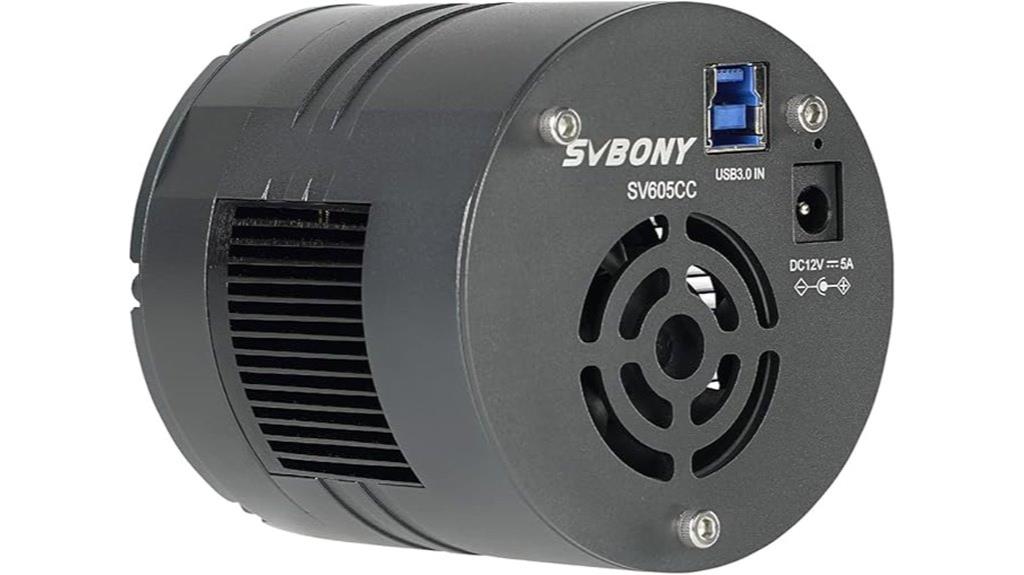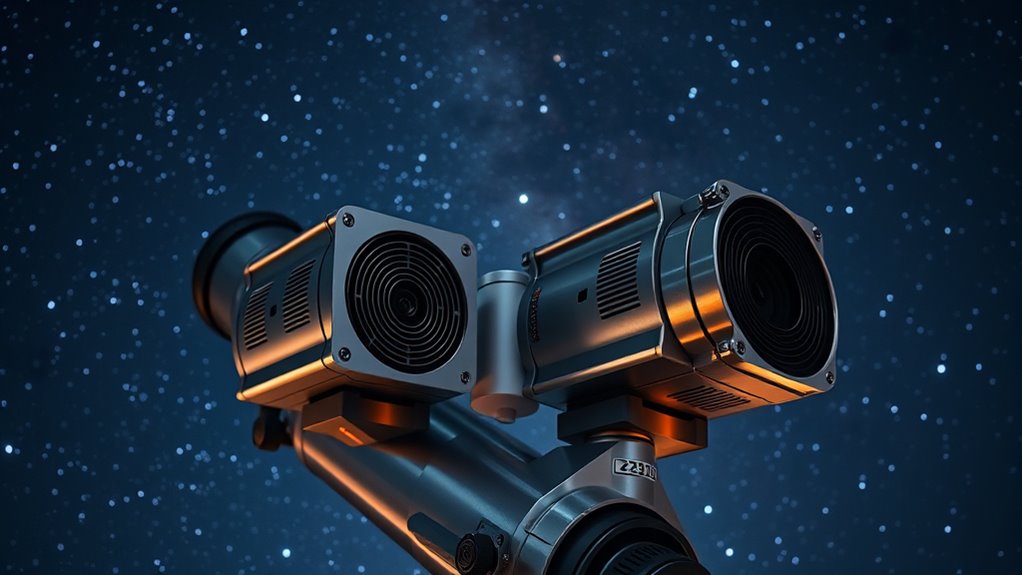In 2025, the top cooled CMOS astro cameras for deep sky imaging are the SVBONY SV605CC and the Astromania SGCMOS series. The SV605CC offers high resolution, excellent cooling, and versatile connectivity, making it great for long exposures and faint objects. The Astromania model provides reliable sensitivity and user-friendly features. Both deliver impressive image quality with efficient noise reduction. If you want to discover which camera best suits your needs and how they perform, you’ll find more insights ahead.
Key Takeaways
- The SVBONY SV605CC and Astromania SGCMOS offer high sensitivity, cooling efficiency, and low noise ideal for deep sky astrophotography.
- Both cameras feature TEC cooling that reduces sensor temperature by 30°C, enhancing image clarity during long exposures.
- Compatibility with multiple operating systems and connectivity options ensures versatile, user-friendly integration into various setups.
- High-resolution sensors with up to 80% quantum efficiency enable detailed imaging of faint celestial objects.
- Market trends in 2025 favor CMOS cameras with advanced cooling and user-centric features, making deep sky imaging more accessible.
SVBONY SV605CC Cooled Camera, 9MP CMOS Telescope Camera

If you’re serious about deep sky astrophotography, the SVBONY SV605CC cooled camera is an excellent choice because its 9MP CMOS sensor with TEC cooling markedly reduces noise, especially in low-light conditions. The IMX533 chip captures detailed images with 3008×3008 resolution and 80% quantum efficiency, making it ideal for capturing faint celestial objects. Its cooling system lowers temperatures by 30°C below ambient, suppressing glow and noise. Compatible with multiple operating systems and Wi-Fi connectivity, it offers manual focus, optical zoom, and video recording. Compact and lightweight, it’s perfect for both indoor and outdoor astrophotography sessions, ensuring sharp, high-quality images every time.
Best For: astrophotographers and astronomy enthusiasts seeking high-resolution, low-noise imaging for deep sky observation and meteor monitoring.
Pros:
- High 9MP CMOS sensor with 3008×3008 resolution for detailed images
- Effective TEC cooling system reduces noise and residual glow for clearer photos
- Compatible with multiple operating systems and Wi-Fi for versatile use
Cons:
- Manual focus may require additional adjustments for precise imaging
- Slightly bulky dimensions could be less portable for field use
- Customer ratings are average, indicating potential variability in user experience
Astromania SGCMOS Series Telescope CMOS Camera

The Astromania SGCMOS Series Telescope CMOS Camera stands out as an ideal choice for amateur and semi-professional astronomers seeking reliable auto-guiding and astrophotography capabilities. Its high-sensitivity sensor, fast frame rate, and long exposure support quality imaging. The aluminum CNC housing guarantees durability and efficient heat transfer, while the built-in ST4 auto guider port simplifies auto-guiding connections. Equipped with a 1.25-inch nosepiece and compatible with native, ASCOM, and WDM drivers, it integrates seamlessly with various software. Whether capturing deep-sky objects or guiding your telescope, this camera offers versatile features in a compact, lightweight package.
Best For: amateur and semi-professional astronomers seeking reliable auto-guiding and astrophotography capabilities with versatile imaging options.
Pros:
- High-sensitivity sensor with fast frame rate and long exposure support for high-quality imaging.
- Durable aluminum CNC housing with efficient heat transfer ensures longevity and optimal sensor performance.
- Compatible with native, ASCOM, and WDM drivers for seamless integration with various software and equipment.
Cons:
- Rated 3.5 out of 5 stars based on customer reviews, indicating mixed user satisfaction.
- Limited to USB 2.0 connectivity, which may be slower compared to newer interfaces.
- Slightly larger and heavier than some compact astrophotography cameras, potentially affecting mounting flexibility.
Factors to Consider When Choosing Cooled CMOS Astro Cameras for Deep Sky Imaging

When selecting a cooled CMOS astro camera for deep sky imaging, I focus on factors like sensor sensitivity, pixel size, and cooling efficiency to guarantee high-quality images. It’s also important to check compatibility with my setup and consider how easy the camera is to operate. These points help me find a camera that balances performance, ease of use, and image quality.
Sensor Sensitivity and Pixels
Have you ever wondered how sensor sensitivity and pixel size influence the performance of cooled CMOS astro cameras in deep sky imaging? Higher sensor sensitivity means the camera can detect more light from faint objects, making it easier to capture detailed images of distant galaxies and nebulae. Larger pixels improve the signal-to-noise ratio, resulting in clearer, more detailed images in low-light conditions. The quantum efficiency percentage shows how effectively the sensor converts incoming photons into digital signals, directly impacting brightness. Smaller pixels offer higher resolution but may need longer exposures or higher gain to reach the desired brightness. When choosing a camera, balancing sensitivity and pixel size is *vital* to capturing sharp, bright images without excessive noise or long wait times.
Cooling Efficiency and Noise Reduction
Effective cooling systems like TEC or Peltier devices play a essential role in reducing sensor temperature by 30°C or more below ambient, which substantially cuts down thermal noise. Lower sensor temperatures decrease dark current, a major noise source during long exposures, enabling clearer images of faint deep sky objects. Improved cooling enhances the camera’s signal-to-noise ratio, resulting in sharper, more detailed astrophotographs. It also allows for longer exposure times without increasing noise levels, indispensable for capturing faint signals. However, maintaining consistent cooling performance is critical; temperature fluctuations can introduce variability and noise artifacts, degrading image quality. When choosing a cooled CMOS camera, I always consider how well its cooling system maintains stable, efficient cooling to maximize noise reduction and achieve the best possible astrophotographs.
Compatibility and Connectivity Options
Choosing a cooled CMOS astro camera with the right connectivity options is vital for a smooth astrophotography experience. I look for cameras that support multiple operating systems like Windows, Linux, Mac OS, and Chrome OS, ensuring versatile compatibility. Wi-Fi or Ethernet connectivity is a game-changer, allowing remote control and data transfer without tangled cables. I also verify compatibility with third-party software through drivers such as ASCOM or WDM, simplifying integration into my workflow. Standard interfaces like USB 3.0 are indispensable for high-speed data transfer, especially for high-resolution imaging. Additionally, I check for extra ports like auto-guiding ST4 connections, which enhance my system’s tracking precision. These connectivity options streamline my setup, making deep sky imaging more efficient and enjoyable.
Image Quality and Resolution
When selecting a cooled CMOS astro camera for deep sky imaging, image quality and resolution are critical factors that can make or break your astrophotography results. Higher resolution sensors, like 9MP or above, allow for capturing more detailed images of celestial objects. The pixel size, often around 3.7μm, determines how well the camera can resolve fine details; smaller pixels generally offer sharper images. Cooling systems such as TEC refrigeration reduce thermal noise, boosting clarity and improving the signal-to-noise ratio. Sensor technology like the IMX533 provides high quantum efficiency—up to 80%—which enhances light sensitivity, essential for faint objects. Ultimately, a camera’s ability to suppress glow and noise directly impacts the sharpness and detail of your astrophotos, making these factors indispensable to consider.
Ease of Use and Setup
Selecting a cooled CMOS astro camera that’s easy to set up and operate can save you a lot of time and frustration, especially when you’re eager to start capturing deep sky objects. Look for cameras with user-friendly interfaces and straightforward setup procedures that minimize initial configuration. Check if the camera comes with extensive software support and clear instructions for installation and calibration, making the process smoother. Compatibility with your operating system and existing equipment is vital to avoid complex integrations. Cameras with automatic or semi-automatic focus and calibration features help simplify image optimization. Additionally, accessible connection options like Wi-Fi or USB enable quick and flexible setup, so you can start imaging sooner. Prioritizing ease of use ensures a more enjoyable and efficient astrophotography experience.
Frequently Asked Questions
How Does Cooling Efficiency Impact Image Quality in CMOS Astro Cameras?
Cooling efficiency directly impacts image quality by reducing thermal noise, which can obscure faint details in deep sky images. When my CMOS astro camera cools effectively, I notice clearer, sharper captures with better contrast. Poor cooling, on the other hand, leads to increased noise and graininess, making it harder to distinguish faint objects. So, high cooling efficiency is essential for achieving high-quality, detailed astrophotography.
Are These Cooled CMOS Cameras Compatible With Popular Astrophotography Software?
Yes, most cooled CMOS astro cameras are compatible with popular astrophotography software like SharpCap, N.I.N.A., and PHD2. I’ve found that manufacturers often provide drivers and SDKs, making integration smooth. Just double-check your camera model’s compatibility before purchase. Overall, these cameras work well with software, giving me confidence to capture deep-sky images effortlessly. Compatibility has never been a major hurdle for me when choosing a cooled CMOS astro camera.
What Is the Typical Lifespan of Cooled CMOS Sensors in Astrophotography?
Think of cooled CMOS sensors as resilient explorers in the vast cosmos; they typically last around 5 to 10 years with proper care. I’ve found that their longevity depends on usage, cooling efficiency, and environmental conditions. Regular maintenance and careful handling can extend their lifespan, much like nurturing a star’s glow. So, if you treat your sensor well, it can serve as your faithful celestial companion for many observing seasons.
Can These Cameras Be Used for Planetary Imaging, or Are They Only Suited for Deep Sky?
Yes, these cooled CMOS astro cameras are versatile and work well for planetary imaging too. Their sensitivity, fast frame rates, and high resolution make them perfect for capturing detailed planetary features. While they’re optimized for deep sky, I’ve found they handle planetary shots excellently. Whether you’re imaging planets or deep-sky objects, these cameras offer flexibility, allowing you to switch between different astrophotography targets with ease.
How Does Sensor Size Affect Field of View and Image Resolution?
Imagine Galileo with a modern camera—sensor size really impacts your view. Larger sensors provide a wider field of view, capturing more sky in a single shot, which is fantastic for deep sky objects. They also deliver higher resolution images, revealing more detail. Smaller sensors focus on zoomed-in shots with sharper detail but cover less sky. So, your choice depends on whether you want broad vistas or detailed close-ups.
Conclusion
After reviewing these top cooled CMOS astro cameras, I’m impressed by their advancements—especially the SVBONY SV605CC’s 9MP sensor, which offers remarkable detail. Did you know that cooled CMOS cameras can reduce noise levels by up to 80%, dramatically improving image clarity? Whether you’re aiming for deep sky wonders or planetary detail, choosing the right camera makes all the difference. Both options deliver excellent value, helping you capture the universe’s beauty with precision and ease.









